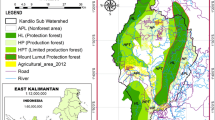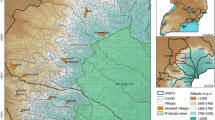Abstract
Shifting cultivation practiced by indigenous peoples living at low population densities in tropical forests has often been described as sustainable and compatible with conservation. However, shifting cultivation at increasing population densities has historically been, and still is, a main cause of deforestation worldwide. As many indigenous peoples in tropical forests currently experience rapid demographic growth, this raises the question to what extent their agricultural activities actually contribute to deforestation. This paper examines land use change in an indigenous community in the Ecuadorian Amazon which is only loosely connected to the market economy, and where agriculture is almost exclusively subsistence oriented. During the last seven decades, people have increasingly begun to clear fallows instead of old-growth forest to farm. Although the population was growing at an estimated 1.6% per year, the expansion of the area of land used for agriculture was only 0.4% per year, corresponding to an annual deforestation rate of only 0.015%. Whereas these changes may seem negligible in terms of deforestation, they do cause hardships to the local people, because of increasing walking distance to old-growth forest, and problems with weeds, pests, and decreasing soil productivity when farming after reclearing fallows.












Similar content being viewed by others
References
Amelung, T. and Diehl, M. (1992). Deforestation of Tropical Rain Forests: Economic Causes and Impact on Development, Kieler Studien, 241.
Angelsen, A. (1997). Tropical Agriculture and Deforestation: Economic Theories and a Study from Indonesia. PhD thesis. Norwegian School of Economics and Business Administration. Bergen.
Angelsen, A. (1999). Agricultural Expansion and Deforestation: Modelling the Impact of Population, Market Forces and Property Rights. Journal of Development Economics 58: 185–218.
Angelsen, A. and Kaimowitz, D. (2001). Agricultural Technologies and Tropical Deforestation, CABI, Oxon.
Aranda, T. and Machoa, M. (1993). Las variedades de yucca en Sarayaku. High school graduation thesis, Colegio Técnico Agropecuario de Sarayaku, Sarayaku, Ecuador.
Baland, J.-M. and Platteau, J.-P. (1996). Halting the Degradation of Natural Resources: Is There a Role for Rural Communities? Oxford University Press, Oxford.
Beckerman, S. (1987). Swidden in Amazonia and the Amazon rim. In Turner, B. L. and Brush, S. B. (eds.), Comparative Farming Systems, Guilford, New York, pp. 55–94.
Behrens, C., Baksh, M. and Mothes, M. (1994). A Regional Analysis of Barí Land Use Intensification and its Impact on Landscape Heterogeneity. Human Ecology 22(6): 279–316.
Boserup, E. (1965). The Conditions of Agricultural Growth: The Economics of Agrarian Change Under Population Pressure, Allen & Unwin, London, UK.
Brondizio, E. S., Moran, E. F., Mausel, P. and Wu, Y. (1994). Land Use Change in the Amazon Estuary: Patterns of Caboclo Settlement and Landscape Management. Human Ecology 22(3): 249–278.
Chagnon, N. A. (1997). Yanomamö, Fort Worth; London, UK: Harcourt Brace College Publishers.
Chávez, G., Lara, R. and Moreno, M. (2005). Sarayaku: El pueblo de cenit. Identidad y construcción étnica. Informe antropológico-jurídico sobre los impactos sociales y culturales de la presencia de la compañia CGC en Sarayaku, FLACSO/CDES, Quito, Ecuador.
Clay, J. W. (1988). Indigenous Peoples and Tropical Forests, Cultural Survival, Cambridge, Massachusetts.
Davis, S. H. and Wali, A. (1994). Indigenous Land Tenure and Tropical Forest Management in Latin America. Ambio 23: 207–212.
Denevan, W. M., Treacy, J. M., Alcorn, J. B., Padoch, C., Denslow, J. and Flores Paitan, S. (1984). Indigenous Agroforestry in the Peruvian Amazon: Bora Indian Management of Swidden Fallows. Interciencia 9(6): 346–357.
Descola, P. (1994). In the Society of Nature, University Press, Cambridge.
Dufour, D. L. (1990). Use of Tropical Rainforests by Native Amazonians. Bioscience 40(9): 652–659.
Edeli, D., Gualinga, B., Malaver, D., Viteri, F., Viteri, R. and Viteri, S. (1998). 1998 Censo y estudio comunitario de Sarayacu, Colegio Técnico Agropecuario Sarayacu, Sarayacu.
Fearnside, P. M. (2003). Conservation Policy in Brazilian Amazonia: Understanding the Dilemmas. World Development 31(5): 757–779.
Garí, J. (2001). Biodiversity and Indigenous Agroecology in Amazonia: The Indigenous People of Pastaza, Etnoecología 5(7): 21–37.
Geist, H. J. and Lambin, E. F. (2002). Proximate Causes and Underlying Driving Forces of Tropical Deforestation. Bioscience 52(2): 143–150.
Gross, D. R. (1983). Village movement in relation to resources in Amazonia. In Hames, R. B. and Vickers, W. T. (eds.), Adaptive Responses of Native Amazonians, Academic, New York, pp. 429–449.
Hames, R. B. (1983). The settlement pattern of a Yanomamö population bloc: A behavioral ecological interpretation. In Hames, R. B. and Vickers, W. T. (eds.), Adaptive Responses of Native Amazonians, Academic, New York, pp. 393–427.
Henrich, J. (1997). Market Incorporation, Agricultural Change and Sustainability among the Machiguenga Indians of the Peruvian Amazon. Human Ecology 25(2).
Johnson, A. (1983). Machiguenga Gardens, Adaptive Responses of Native Amazonians, Academic.
Jordan, C. F. (1987). Shifting cultivation. In Jordan, C. F. (ed.), Amazonian Rain Forests: Ecosystem Disturbance and Recovery, Ecological Studies 60, Springer, Berlin Heidelberg New York, pp. 9–23.
Kaimowitz, D. and Angelsen, A. (1998). Economic Models of Tropical Deforestation: A Review, CIFOR. Bogor, Indonesia.
McGrath, D. G. (1987). The Role of Biomass in Shifting Cultivation. Human Ecology 15(2): 221–242.
Nye, P. H. and Greenland, D. J. (1960). The Soil Under Shifting Cultivation, Commonwealth Bureau of Soils, Bucks.
Pedersen, H. B. and Balslev, H. (1992). Palmas utiles: especies ecuatorianas para agroforestería y extractivismo, Abya-Yala, Quito.
Peres, C. A. (1994). Indigenous Reserves and Nature Conservation in Amazonian Forests, Conservation Biology 8: 586–589.
Raintree, J. B. and Warner, K. (1986). Agroforestry Pathways for the Intensification of Shifting Cultivation. Agroforestry Systems 4: 39–54.
Robinson, J. G. and Bennett, E. L. (2000). Carrying capacity limits to sustainable hunting in tropical forests. In Robinson, J. G. and Bennett, E. L. (eds.), Hunting for Sustainability in Tropical Forests, Columbia University Press, New York, pp. 13–30.
Rudel, T. K. (1995). When do Property Rights Matter? Open Access, Informal Social Controls, and Deforestation in the Ecuadorian Amazon. Human Organization 54(2): 187–194.
Rudel, T. K. and Horowitz, B. (1996). Pequeños agricultores y desmonte agrícola en la Amazonía Ecuatoriana, Abya-Yala, Quito.
Rudel, T. K., Bates, D. and Machinguiasli, R. (2002). Ecologically Noble Amerindians? Cattle, Ranching and Cash Cropping Among Shuar and Colonists in Ecuador. Latin American Research Review 37(1): 144–159.
Salick, J. (1989). Ecological Basis of Amuesha Agriculture, Peruvian Upper Amazon. Advances in Economic Botany (7): 189–212.
Sawyer, S. (1997). The 1992 Indian Mobilization in Lowland Ecuador, Latin American Perspectives 24(3).
Sayer, J. A. (1995). Science and International Nature Conservation, CIFOR Occasional Paper, 4, Jakarta.
Schwartzman, S., Moreira, A. and Nepstad, D. (2000). Rethinking Tropical Forest Conservation: Perils in Parks, Conservation Biology 14(5): 1351–1357.
Sirén, A. (2004). Changing interactions between humans and nature in Sarayaku, Ecuadorian Amazon, Acta Universitatis Agriculturae Sueciae: Agraria 447. http://diss-epsilon.slu.se/archive/00000498/)
Sirén, A. H. (2006). Natural Resources on Indigenous Peoples’ Land in Amazonia: A Tragedy of the Commons? The International Journal of Sustainable Development and World Ecology.
Sirén, A., Hambäck, P. and Machoa, J. (2004). Including Spatial Heterogeneity and Animal Dispersal when Evaluating Hunting: A Model Analysis and an Empirical Assessment in an Amazonian Community. Conservation Biology 18(5): 1315–1329.
Sponsel, L. E. (1992). The environmental history of Amazonia: Natural and human disturbances, and the ecological transition. In Steen, H. K. and Tucker, R. P. (eds.), Changing Tropical Forests: Historical Perspectives on Today’s Challenges in Central & South America, Forest History Society/IUFRO Forest History Group, pp. 233–251.
Tiffen, M., Mortimore, M. and Gichuki, F. (1994). Population Growth and Environmental Recovery: Policy Lessons from Kenya, IIED, London.
Toivonen, T., Kalliola, R., Ruokolainen, K. and Malik, R.N. (2006). Across-path DN Gradient in Landsat TM Imagery of Amazonian Forests: A Challenge for Image Interpretation and Mosaicking, Remote Sensing of Environment 100: 550–562.
Turner, T. (1999). Indigenous rights, environmental protection and the struggle over forest resources in the Amazon: The case of the Brazilian Kayapó. In Conway, J. K., Keniston, K. and Marx , L. (eds.), Earth, Air, Fire, Water: Humanistic Studies of the Environment, University of Massachusetts Press, Amherst.
Unruh, J. D. (1990). Iterative Increase of Economic Tree Species in Minged Swidden-fallows of the Amazon. Agroforestry Systems 11: 175–197.
Zimmerman, B., Peres, C. A., Malcolm, J. R. and Turner, T. (2001). Conservation and Development Alliances with the Kayapo of South-eastern Amazonia, a Tropical Forest Indigenous People. Environmental Conservation 28(1): 10–22.
Acknowledgements
This article is based on research made during my PhD studies at the Department of Rural Development at the Swedish University of Agricultural Sciences, funded mainly by SIDA. I did the remote sensing and GIS analysis with the help of Eduardo Brondizio and Scott Hetrick at the Anthropological Center for Training and Research on Global Environmental Change, Indiana University, where I spent five months with a fellowship funded by STINT. I reformatted the material in my PhD monograph into this article manuscript when working at the department of biology at the University of Turku, Finland, funded by the Academy of Finland. Thanks to Jan Bengtsson, Eduardo Brondizio, David Gibbon, and two anonymous reviewers for reviewing previous versions of the manuscript. Thanks to my field assistant José Machoa, to the Government Council of Sarayaku, and to all the people of Sarayaku who contributed to this study.
Author information
Authors and Affiliations
Corresponding author
Rights and permissions
About this article
Cite this article
Sirén, A.H. Population Growth and Land Use Intensification in a Subsistence-based Indigenous Community in the Amazon. Hum Ecol 35, 669–680 (2007). https://doi.org/10.1007/s10745-006-9089-y
Published:
Issue Date:
DOI: https://doi.org/10.1007/s10745-006-9089-y




